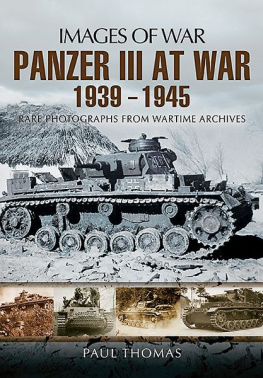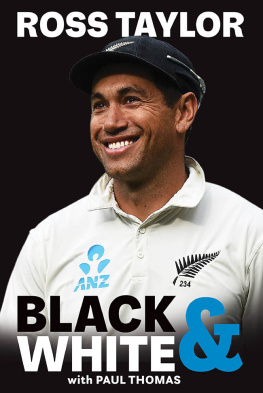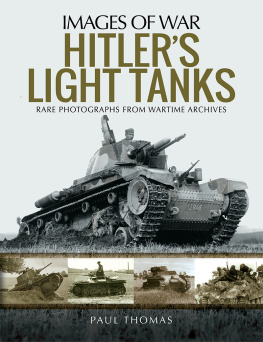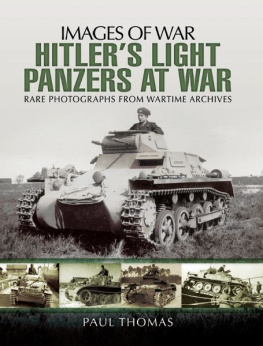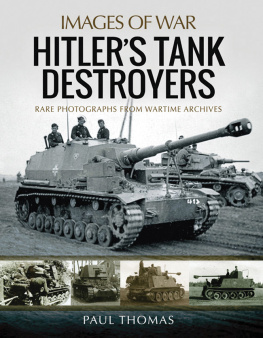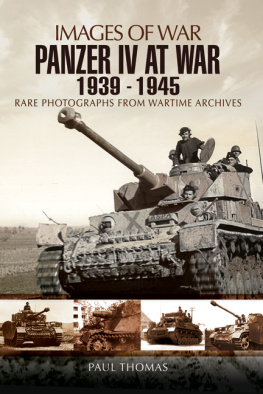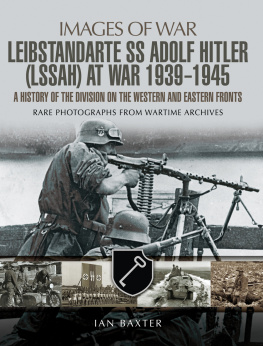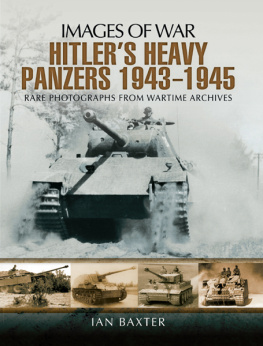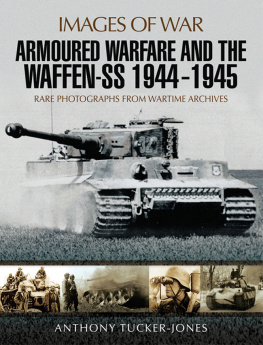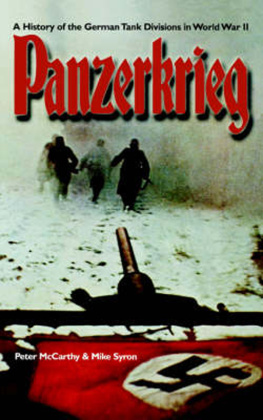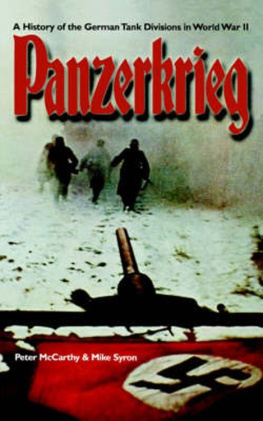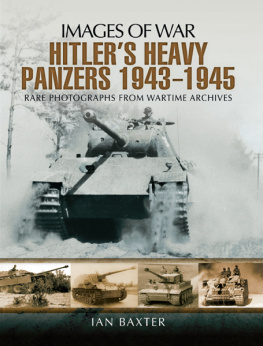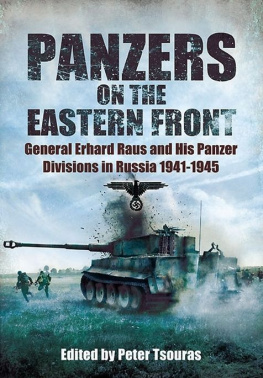Paul Thomas - Panzer III at War 1939-1945 (Images of War)
Here you can read online Paul Thomas - Panzer III at War 1939-1945 (Images of War) full text of the book (entire story) in english for free. Download pdf and epub, get meaning, cover and reviews about this ebook. year: 2013, publisher: Pen and Sword Military, genre: Non-fiction. Description of the work, (preface) as well as reviews are available. Best literature library LitArk.com created for fans of good reading and offers a wide selection of genres:
Romance novel
Science fiction
Adventure
Detective
Science
History
Home and family
Prose
Art
Politics
Computer
Non-fiction
Religion
Business
Children
Humor
Choose a favorite category and find really read worthwhile books. Enjoy immersion in the world of imagination, feel the emotions of the characters or learn something new for yourself, make an fascinating discovery.
- Book:Panzer III at War 1939-1945 (Images of War)
- Author:
- Publisher:Pen and Sword Military
- Genre:
- Year:2013
- Rating:5 / 5
- Favourites:Add to favourites
- Your mark:
- 100
- 1
- 2
- 3
- 4
- 5
Panzer III at War 1939-1945 (Images of War): summary, description and annotation
We offer to read an annotation, description, summary or preface (depends on what the author of the book "Panzer III at War 1939-1945 (Images of War)" wrote himself). If you haven't found the necessary information about the book — write in the comments, we will try to find it.
Panzer III at War 1939-1945 (Images of War) — read online for free the complete book (whole text) full work
Below is the text of the book, divided by pages. System saving the place of the last page read, allows you to conveniently read the book "Panzer III at War 1939-1945 (Images of War)" online for free, without having to search again every time where you left off. Put a bookmark, and you can go to the page where you finished reading at any time.
Font size:
Interval:
Bookmark:

First published in Great Britain in 2013 by
P E N & S W O R D M I L I T A R Y
An imprint of
Pen & Sword Books Ltd
47 Church Street
Barnsley
South Yorkshire
S70 2AS
Copyright Paul Thomas, 2013
PAPERBACK ISBN: 978-1-78159-040-9
PDF ISBN: 978-1-47382-913-8
EPUB ISBN: 978-1-47382-827-8
PRC ISBN: 978-1-47382-870-4
The right of Paul Thomas to be identified as author of this work has been asserted by him in
accordance with the Copyright, Designs and Patents Act 1988.
A CIP catalogue record for this book is available from the British Library.
All rights reserved. No part of this book may be reproduced or transmitted in any form or by any
means, electronic or mechanical including photocopying, recording or by any information storage
and retrieval system, without permission from the Publisher in writing.
Typeset by Concept, Huddersfield, West Yorkshire
Printed and bound in England by CPI Group (UK) Ltd, Croydon, CR0 4YY.
Pen & Sword Books Ltd incorporates the Imprints of Pen & Sword Aviation,
Pen & Sword Family History, Pen & Sword Maritime, Pen & Sword Military, Pen & Sword Discovery,
Wharncliffe Local History, Wharncliffe True Crime, Wharncliffe Transport, Pen & Sword Select,
Pen & Sword Military Classics, Leo Cooper, The Praetorian Press, Remember When,
Seaforth Publishing and Frontline Publishing.
For a complete list of Pen & Sword titles please contact
PEN & SWORD BOOKS LIMITED
47 Church Street, Barnsley, South Yorkshire, S70 2AS, England
E-mail:
Website: www.pen-and-sword.co.uk
Contents
Introduction
T is the second instalment of a new unique series detailing the complete history of the Panzer tank at war. The Panzer III at War 19391945 is a highly illustrated record revealing one of the foremost German fighting machines of the Second World War. With comprehensive captions and text, the book tells the story of the production of the Panzer III through to the key battles in Poland, France, North Africa, Italy, Russia and North-West Europe.
Throughout the book it shows how the Panzer III evolved and describes how the Germans carefully utilized all available reserves and resources into building numerous variants that went into production and saw action on the battlefield. It depicts how these formidable tanks were adapted and up-gunned to face the ever-increasing enemy threat.
Between 1936 and 1945, thousands of Panzer IIIs were built. For the majority of the war this tank was certainly a match for its opponents tanks and quickly and effectively demonstrated its superiority on the battlefield. In fact, it played a crucial part in the desperate attempt to halt the Soviet drive, and was also used with deadly effect in the West performing defensive operations.
The Panzer III was an ultimate credit to the Panzer divisions it served. The crews that rode and fought in this vehicle from the blitzkrieg days of Poland and France to the defeat at Kursk and the German retreat across Russia were proud of its effectiveness and reliability on the battlefield.
Chapter One
Blitzkrieg 193941
F or the invasion of Poland the Panzerkampfwagen III, commonly known as Pz.Kpfw III, made its debut for the first time on the battlefield. This medium tank developed in the 1930s was primarily designed to fight other armoured fighting vehicles and as an infantry support tank, which included supporting the Panzer IV.
The Pz.Kpfw III variants A through to C had 15mm of homogeneous steel armour on all sides with 10mm on top and 5mm on the bottom. During the invasion of Poland tank commanders knew that this new Panzer would certainly be well protected against their lightly-armed opponents. It moved out onto the battlefield with the sole intention of fighting with other tanks. It was initially equipped with the 3.7cm KwK 36 L/46.5, which proved more than adequate streaming across Poland. The Panzer III Ausf. A through C were powered by a 250 PS (184 kW) 12-cylinder Maybach HL 108 TR engine, giving a top speed of 32 kph (20 mph) and a range of 150 km (93 miles).
For the invasion of Poland only 98 Pz.Kpfw IIIs were available, compared to 1,445 Pz.Kpfw Is, 1,223 Pz.Kpfw IIs and 211 Pz.Kpfw IVs. This meant that eight Panzer IIIs were incorporated in each light tank company, but some divisions had none as a result. Nonetheless, during the early hours of 1 September 1939, the German army finally crossed the Polish frontier and began Operation White, the code-name for the German invasion of Poland. For the attack the German army was broken up into two army groups: Army Group North, consisting of the Fourth and Third armies under the command of General Fedor von Bock; and the Southern Army Group, consisting of the Eighth, Tenth and Fourteenth armies commanded by General Gerd von Rundstedt. From north to south all five German army groups crashed over the frontier. Almost immediately they quickly began achieving their objectives.
The entire thrust of the German army was swift and devastatingly efficient. Blitzkrieg had arrived. From the beginning of the invasion the Luftwaffe had paralysed large sections of the Polish railway network, severely disrupting the desperately-needed mobilization, which was still far from completed. The Poles were faced with the finest fighting army that the world had ever seen. The quality of the German weapons above all the Panzers was of immense importance during the Polish campaign.
Within a month the Polish campaign came to a victorious conclusion and the Panzerwaffe were heralded as heroes for their part in the destruction of Poland. The Panzer III had played a significant part in the crushing of the Polish army. Along with its powerful force it had engaged in an innovative new form of mobile warfare. The Panzer IIIs 3.7cm gun had proved to be more than enough firepower to deal with the Polish army tanks, which were grouped in light tank battalions and light tank companies. While the majority of these Polish tank men were patriotic to their last breath, they were outclassed by the Panzer. However, they still managed to destroy a number of German vehicles as they simultaneously defended their country from both the might of the Germans and then the Soviet invasion from the east.
According to German figures, the Panzerwaffe lost some 1,000 fighting vehicles, most of which were knocked out during the campaign by anti-tank guns. Only twenty-six Pz.Kpfw IIIs were completely destroyed.
While the losses for the Germans were considered relatively light, the Polish campaign had certainly taught them a lesson in tactical mobile warfare. It had demonstrated the speed and power necessary for the Panzers to achieve their objectives quickly and decisively. At the same time it had provided the tank crews and their commanders with real experience of using armour in battle conditions. Poland for the Panzerwaffe was a complete success, and from the lessons in the east they were going to turn their less under-gunned vehicles into some of the most deadly fighting machines in the world.
Eight months later the Panzerwaffe were again called up for action, this time against the west. For this attack the German army was divided into three army groups: A, B and C. The main strike would be given to Army Group A, which would drive its armoured units through the Ardennes, swing round across the plains of northern France and then make straight for the Channel coast, thereby cutting the Allied force in half and breaking the main enemy concentration in Belgium between Army Group A advancing from the south and Army Group B in the north. The task of Army Group B was to occupy Holland with motorized forces and to prevent the linking-up of the Dutch army with Anglo-Belgian forces. It was to destroy the Belgian frontier defences by a rapid and powerful attack and throw the enemy back over the line between Antwerp and Namur. The fortress of Antwerp was to be surrounded from the north and east and the fortress of Liege from the north-east and north of the Meuse. Army Group C, which was the southernmost of the three army groups, was to engage the garrison of the Maginot Line, penetrating it if possible.
Next pageFont size:
Interval:
Bookmark:
Similar books «Panzer III at War 1939-1945 (Images of War)»
Look at similar books to Panzer III at War 1939-1945 (Images of War). We have selected literature similar in name and meaning in the hope of providing readers with more options to find new, interesting, not yet read works.
Discussion, reviews of the book Panzer III at War 1939-1945 (Images of War) and just readers' own opinions. Leave your comments, write what you think about the work, its meaning or the main characters. Specify what exactly you liked and what you didn't like, and why you think so.

